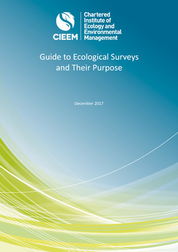|
In November 2017, Natural England updated the Standing Advice relating to Ancient Woodland and Veteran Trees - this advice has been tweaked in January 2018 to revise some of this advice.
In relation to veteran trees, the advice updated in November 2017 has not been amended. This advice introduced a key recommendation for a "buffer zone at least 15 times larger than the diameter of a veteran tree or 5m from the edge of its canopy, if that’s greater" and "protecting veteran trees by designing open space around them".
This is potentially important for developers as it is an increase on the maximum root protection area of 15m recommended by the arboricultural British Standard, BS 5837). For further information, please feel free to contact us on [email protected] or call us on 01379 890770.
1 Comment
The Chartered Institute of Ecology and Environmental Management (or CIEEM) has recently published a guide to ecological surveys and their purpose, which aim to provide guidance for those undertaking preliminary ecological surveys and appraisals. Click on the image below or here to access the guidance on the CIEEM webpage.  The guidance clearly sets out the approach needed to ensure that planning applications are compliant with statutory legislation relating to nature conservation as well as planning policy, including those policies specified in local plans, as well as in the National Planning Policy Framework (NPPF). I see this guidance as reflecting the approach that I have successfully developed and applied in nearly 20 years of working as a professional ecologist. Essentially, there are two key stages within a Ecological Impact Assessment process that culminate in an EcIA report that accompanies a planning application. 1. A Preliminary Ecological Appraisal (PEA), which normally comprises a desk study and a high-level ecological survey of the site, often using a method known as an Extended Phase 1 Habitat Survey. The aim of this survey is to identify the ecological features present, or potentially present, with a Site or its surrounding area. A PEA Report may be produced but is seldom sufficient for planning purposes as its aim is to determine whether further surveys (often referred to as Phase 2 Surveys) are required or to inform the design team on any ecological issues that may need to be considered within the proposed scheme. A PEA can be used to scope the ecological issues relevant to a site; where a Site may be very straight forward, with no significant ecological issues, a PEA report may be sufficient. 2. An Ecological Impact Assessment (EcIA) is the process used to assess the likely significant effects of any development project or scheme on the ecological features and biodiversity that could be affected. This involves the survey information obtained from an extended Phase 1 Habitat Survey as well as any further Phase 2 surveys that may be required, for example, for birds, reptiles, amphibians (such as great crested newt) or mammals (bats, otters, water voles etc). To accompany a planning application, an EcIA report is prepared that should be structured based on guidance set out in CIEEM's Guidelines for Ecological Report Writing to provide the appropriate level of information to the planning decision-maker sufficient to answer the following questions:
For more information about ecological surveys and/or assessments, please feel free to contact us for an informal, no obligation discussion, where I would be happy chat about these issues further. |
Jon HuckleThis is intended to host my articles on ecology, news about what I am up to, and general musings or ramblings about things that concern me.... Archives
February 2023
Categories
All
|
 RSS Feed
RSS Feed
